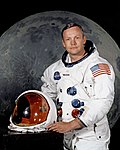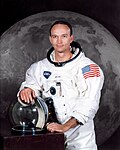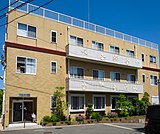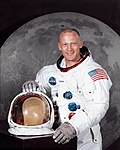From today's featured articleNeil Armstrong (1930–2012) was an astronaut and aeronautical engineer who was the first person to walk on the Moon. He was a United States Naval Aviator who served in the Korean War and later worked as a civilian test pilot for experimental aircraft. Armstrong joined the NASA Astronaut Corps in the second group, selected in 1962; he made his first spaceflight as command pilot of Gemini 8 in March 1966, becoming NASA's first civilian astronaut to fly in space. During this mission with pilot David Scott, he completed the first docking of two spacecraft. In July 1969, Armstrong and Apollo 11 Lunar Module pilot Buzz Aldrin performed the first crewed Moon landing, while Michael Collins remained in lunar orbit in the command module. Stepping onto the lunar surface, Armstrong said: "That's one small step for [a] man, one giant leap for mankind." He was later awarded the Presidential Medal of Freedom, the Congressional Space Medal of Honor and the Congressional Gold Medal. (Full article...)
Recently featured:
Did you know...
|
In the news
On this dayJuly 21: Seventeenth of Tammuz (Judaism, 2019)
Charles Tristan, marquis de Montholon (b. 1783) · Russell Lee (b. 1903) · Rilwanu Lukman (d. 2014) |
Today's featured picture
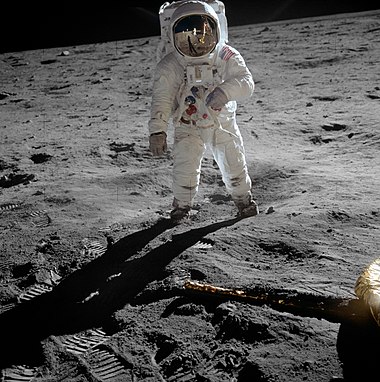
|
Apollo 11 was the fifth crewed mission of NASA's Apollo program. After launching from the Kennedy Space Center in Florida on July 16, 1969, commander Neil Armstrong and Apollo Lunar Module pilot Buzz Aldrin landed Eagle in Mare Tranquillitatis on July 20, at 20:17:40 UTC, while command module pilot Michael Collins remained on Columbia in lunar orbit. Armstrong was the first to exit the spacecraft, stepping onto the surface 6 hours and 39 minutes later, on July 21, at 02:56:15 UTC; nineteen minutes later, Aldrin joined him on extravehicular activity, which lasted 2 hours, 31 minutes and 40 seconds. Armstrong and Aldrin lifted off from Tranquility Base after almost 22 hours on the lunar surface and rejoined Collins in the command module, before splashing down in the Pacific Ocean on July 24. The mission was planned to the minute, with the majority of the photographic tasks performed by Armstrong with a single Hasselblad camera. Most of the photographs taken on the Moon that include an astronaut are of Aldrin; there are only five images of Armstrong partly shown or reflected, as in this photograph, with Armstrong and the lunar module reflected in Aldrin's helmet visor. "As the sequence of lunar operations evolved," Aldrin explained, "Neil had the camera most of the time [...] It wasn't until we were back on Earth and in the Lunar Receiving Laboratory looking over the pictures that we realized there were few pictures of Neil." Photograph credit: Neil Armstrong
Recently featured:
|
Other areas of Wikipedia
- Community portal – Bulletin board, projects, resources and activities covering a wide range of Wikipedia areas.
- Help desk – Ask questions about using Wikipedia.
- Local embassy – For Wikipedia-related communication in languages other than English.
- Reference desk – Serving as virtual librarians, Wikipedia volunteers tackle your questions on a wide range of subjects.
- Site news – Announcements, updates, articles and press releases on Wikipedia and the Wikimedia Foundation.
- Village pump – For discussions about Wikipedia itself, including areas for technical issues and policies.
Wikipedia's sister projects
Wikipedia is hosted by the Wikimedia Foundation, a non-profit organization that also hosts a range of other projects:
Free media repository
Wiki software development
Wikimedia project coordination
Free textbooks and manuals
Free knowledge base
Free-content news
Collection of quotations
Free-content library
Directory of species
Free learning materials and activities
Free travel guide
Dictionary and thesaurus
